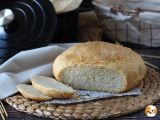Homemade bread without yeast: the recipe to try now!

The smell of freshly baked bread is always inviting. However, when yeast is lacking or quicker preparation is desired, yeast-free bread, also known as soda bread, provides an excellent alternative. It requires few ingredients, no leavening time and guarantees an amazing result: a loaf that is crispy on the outside and soft on the inside, ideal to enjoy warm or store for several days.
We bring you a simplified and affordable version of the traditional Irish recipe, designed to walk you through it step by step with clear instructions and practical advice. Even if it's your first time with homemade bread, you'll be able to achieve a fragrant and surprising result.
Ingredients
The beauty of soda bread is that it is made with what we normally have in the pantry. Here are the basic ingredients.
For the buttermilk:
- 12 fl oz/350 ml milk
- 1.7 oz/50 ml lemon juice
For the dough:
- 3 + 2/3 cup/450 g all-purpose flour
- 1 tsp baking soda (or baking powder)
- 1 tsp sugar
- 1 tsp salt
1. Prepare the buttermilk
Buttermilk is the key ingredient to activate the chemical reaction with the baking soda, allowing the bread to grow and become soft even without yeast.
- Pour the buttermilk into a bowl.
- Add the lemon juice (or white vinegar).
- Stir and let stand at room temperature for 15 minutes.
You will notice that the milk will begin to curdle slightly-this is a completely normal process. You will then get a mixture with a slightly thick consistency and a sour taste, ideal for this recipe.
2. Mixing the dry ingredients
In a large bowl, combine:
- 3 + 2/3 cup/450 g all-purpose flour
- 1 tsp baking soda (or baking powder)
- 1 tsp sugar
- 1 tsp salt
Mix well with a hand whisk or fork to evenly distribute the baking soda and salt. This step is critical to avoid unleavened areas or excessively salty flavor in some places.
3. Combine the buttermilk and knead.
Slowly pour the buttermilk into the bowl with the dry ingredients, stirring with a wooden spoon or directly with your hands. The dough should be soft and slightly sticky, but not too runny. There is no need to knead it for a long time: 1-2 minutes is enough to mix all the ingredients well. Excessive kneading, in fact, risks making the bread harder after baking.
Tips:
- If the dough is too dry, add a tablespoon of buttermilk at a time.
- If the dough is too soft, you can add a little flour (without overdoing it).
4. Form the loaf of bread
Transfer the dough to a baking sheet covered with baking paper. You can shape it directly with your hands, giving it a round shape and about 2-3 inches/5-6 cm high-a mold is not necessary. If you prefer, you can use a rectangular mold for convenience (as we did). Score the surface with diagonal lines using a knife-this way the bread will also bake better on the inside.
5. Baking in the oven
Preheat the oven to 390°F/200°C (static). Bake the bread and bake for about 30-40 minutes. How to tell if it is baked? Tap gently with your knuckles on the bottom of the loaf: if it sounds "hollow," it's ready.
Tip: If the crust darkens too much on the surface but the bread is still raw inside, cover it with aluminum foil for the last 10 minutes of baking.
Variants to try
Once you have mastered the basic recipe, you can indulge in these variations:
- Adding seeds: flax, sesame, poppy or sunflower.
- Herbs: rosemary, oregano, thyme for a fragrant bread.
- Grated cheese: for a savory and irresistible version.
- Raisins and nuts: for a sweet variation perfect for breakfast.
Conclusion: simple, fast and no waiver
Yeast-free bread is the ideal alternative for those looking for a quick, natural solution with no waiting time. Perfect if you are short on time, intolerant to yeast, or love to experiment in the kitchen. With this recipe ready, just turn on the oven-the scent of your soda bread will do the rest.
You might also be interested in:
 Daniele Mainieri
Daniele Mainieri